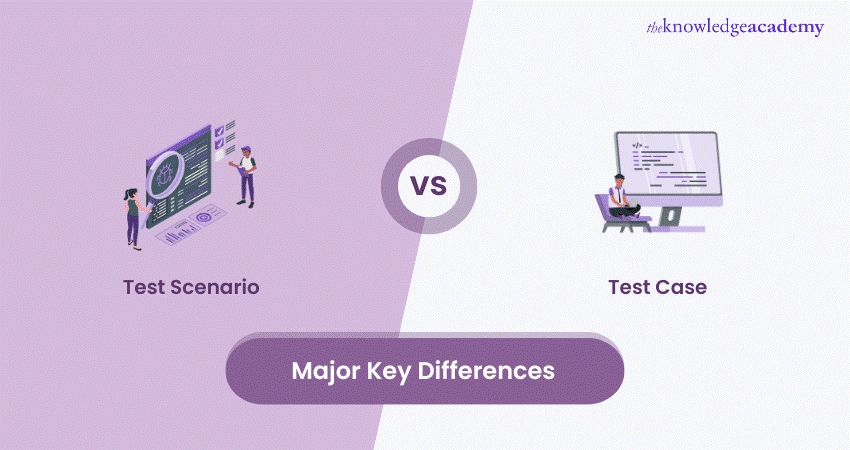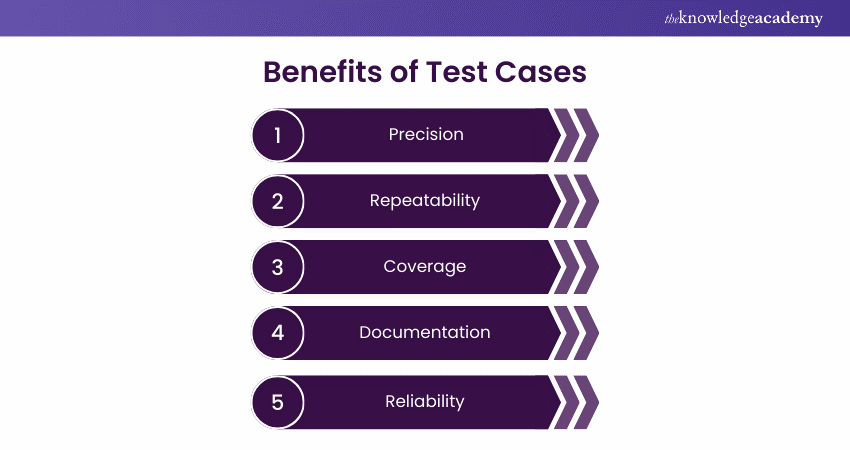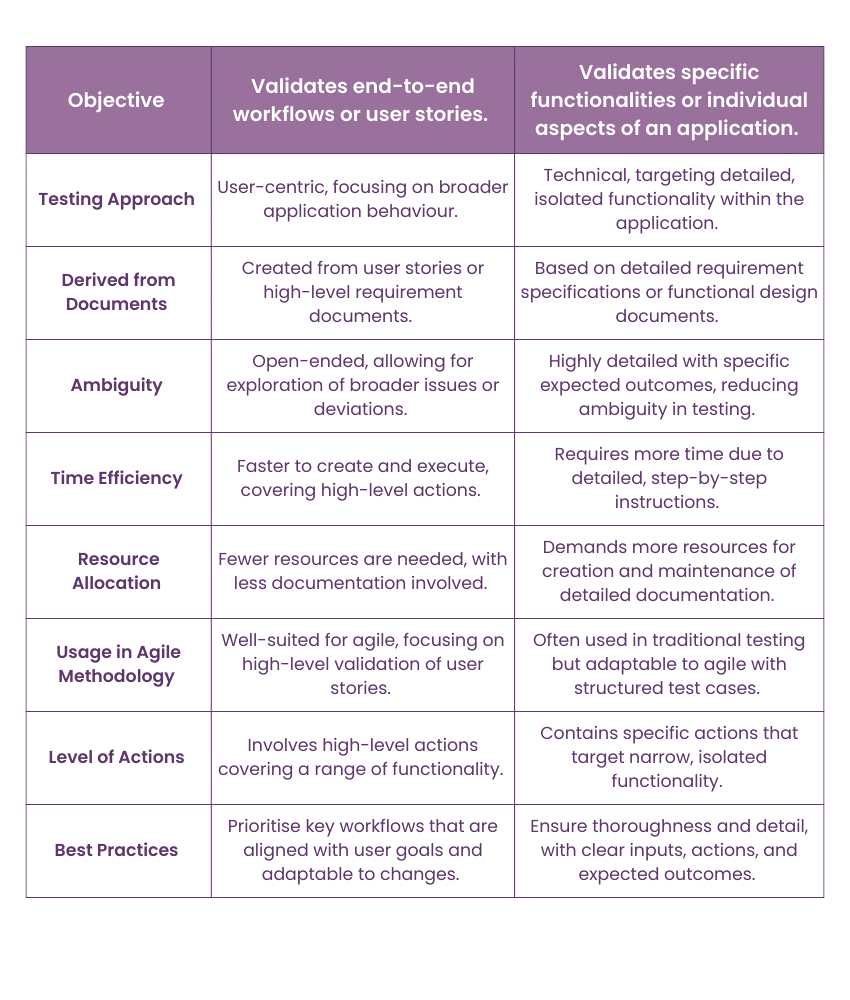We may not have the course you’re looking for. If you enquire or give us a call on +32 35001305 and speak to our training experts, we may still be able to help with your training requirements.
Training Outcomes Within Your Budget!
We ensure quality, budget-alignment, and timely delivery by our expert instructors.

In the ever-developing field of software testing, there is hardly any difference between test scenarios and test cases on the surface. Despite the fact that these two elements are constituent components of the frameworks of testing strategies, they operate in rather different ways within that testing sphere.
The difference is in the nature of their application as well as in the method of their implementation, which is why it must be clear to software testers when and how to apply each of these instruments.
Thus, the Test Scenario vs Test Case becomes even more important because of the nature of such methodologies as agile and the tendencies towards more frequent releases. This blog post explains the difference between all of them, contrasting their goals, techniques, and advantages, to enable teams to make smarter testing choices.
Table of Contents
1) What is a Test Case?
a) Benefits of Test Case
2) What is a Test Scenario?
a) Benefits of Test Scenario
3) Differences between Test Scenario and Test Case
a) Objective
b) Testing Approach
c) Derived from documents
4) Conclusion
What is a Test Case?
A test case is a series of actions designed to evaluate and validate specific features or functionalities of an application. Each test case has step-by-step procedures, passing grading criteria and is sometimes linked with input.
In other words, a test case is very specific and addresses segments of the system, which positively impacts the specificity of checks.
While it is most useful when used to identify faults in small, isolated units of an application. They describe each activity clearly so they can be trusted to keep track of defects and can be replicated freely.
A single test case is usually developed to meet only one requirement or scenario that characterises the system's behaviour and so it provides a micro-level examination of the system.
Benefits of Test Case
The following are the benefits and the advantages of the test case:

a) Precision: Test cases provide step-by-step instructions for testers, ensuring tests are replicated accurately.
b) Repeatability: They facilitate consistent results in repeated tests, which is vital for debugging.
c) Coverage: By focusing on specific components, they ensure thorough coverage of individual functions.
d) Documentation: Detailed test cases enhance organised documentation, which is valuable for future testing.
e) Reliability: With each step documented, test cases support reliable tracking and reproducibility.
What is a Test Scenario?
A test scenario is a document that briefly outlines the complete functionality of the software, typically in a single sentence, from the perspective of an end user. The situation aims to replicate a real-world experience the user will encounter while utilising the software.
This document concentrates on what must be tested, assisting the testing teams in managing the testing process. Because test scenarios rely on a high level of actions and include brief descriptions, they are relatively easy to create and modify in real-time.
Test scenarios serve as a valuable time-saver and suit organisations and teams utilising agile methodologies. Each member of the testing team can quickly access the document and see which tests have been completed, allowing them to begin working on the next scenario.
Achieve elite status in testing with our Software Testing Black Belt Register now!
Benefits of Test Scenario
The following pointers are the benefits and the advantages of the Test Scenarios:
a) Broader Coverage: Test scenarios encompass larger workflows and adopt a user-centric approach.
b) Flexibility: They facilitate exploratory testing, easily adapting to changes and updates.
c) Real-world Perspective: By mimicking real-world usage, scenarios help identify critical user issues.
d) Efficiency: Test scenarios take less time to create and execute compared to detailed test cases.
e) Agile-friendly: They integrate well into agile frameworks, emphasising user stories over intricate details.
Differences Between Test Scenario and Test Case
The table below shows the difference between the test scenario and the test case:

Objective
a) Test Scenario: Aims to validate broader user workflows or processes, focusing on the application’s end-to-end behaviour. For example, in an e-commerce application, a test scenario might be “User places an order,” covering actions from selecting a product to confirming a purchase.
b) Test Case: Focuses on verifying specific functionalities within the application, breaking down workflows into detailed steps. For instance, testing the “Add to Cart” button to ensure it correctly adds items to the cart.
Testing Approach
a) Test Scenario: Adopts a user-centric approach, testing the software as a whole with an emphasis on real-life user actions and journeys. This helps assess whether key features align with user expectations during common workflows.
b) Test Case: Follows a technical and structured approach, detailing each action required to perform the test. This is useful for identifying bugs in isolated components, ensuring specific functionalities are reliable.
Derived from Documents
a) Test Scenario: Generally created from high-level documents like user stories, requirements, or use cases, aiming to verify high-level goals by assessing workflows and processes.
b) Test Case: Derived from detailed documentation such as requirement specifications, functional design documents, and technical specifications, targeting specific functionality for detailed verification.
Ambiguity
a) Test Scenario: Broader and more open-ended, allowing testers to explore and identify potential issues within a workflow without strict expectations. This flexibility is useful for testing complex applications or unknown areas.
b) Test Case: Specific and precise, with clear steps and expected outcomes to minimise ambiguity. This ensures reproducibility and makes it easier to pinpoint and document issues.
Time Efficiency
a) Test Scenario: Quicker to develop and execute, focusing on high-level workflows rather than specific steps. This allows for broader coverage in less time, which is advantageous in agile sprints.
b) Test Case: Requires more time for creation and execution due to detailed instructions and expected results. Essential for regression testing to verify consistent functionality.
Resource Allocation
a) Test Scenario: Requires fewer resources, involving less documentation and fewer specific instructions. Easier to adapt to changes, suitable for agile environments where flexibility is key.
b) Test Case: Demands more resources for detailed documentation and precise execution. Resource-intensive, especially in projects with frequent updates or new features.
Usage in Agile Methodology
a) Test Scenario: Well-suited for agile environments, aligning with the high-level, user-centred focus of agile methodology. Enables rapid validation of user stories without excessive detail.
b) Test Case: This can be adapted for agile projects, though traditionally more common in structured approaches like Waterfall. Requires careful prioritisation to ensure critical cases are created within an agile rapid pace.
Level of Actions
a) Test Scenario: Involves high-level actions encompassing complete workflows or end-to-end functionality. Evaluates whether the application meets user requirements under various conditions.
b) Test Case: Consists of specific, detailed actions targeting individual functionalities within a workflow. For example, verifying steps like entering shipping details or selecting a payment method.
Best Practices
a) Test Scenario: Prioritise main user workflows, ensuring scenarios reflect real-world usage patterns. Keep scenarios adaptable to changes, helping testers quickly assess critical functionalities.
b) Test Case: Ensure thorough documentation with clear inputs, actions, and expected outcomes. Promote consistency and allow team members to execute tests with minimal guidance. Keep test cases organised and accessible for long-term efficiency.
Conclusion
Understanding the differences between Test Scenarios and Test Cases enables teams to choose the best approach for each testing phase. While test scenarios offer flexibility and a user-centered view for broader workflows, test cases provide precision and detailed validation for specific functions. Using both effectively enhances testing coverage, optimises resources, and ensures applications meet user expectations.
Become a testing expert with our Software Testing Automation Course Register now!
Frequently Asked Questions

A test scenario must provide a broad overview of the feature to be evaluated, detailing the user's workflow or process. It ought to emphasise complete interactions, anticipated results, and any essential conditions, offering a transparent perspective on how the feature will function in practical scenarios.

The limitations of scenario testing involve its wide scope, which might miss particular bugs in separate components. It is less comprehensive, making it difficult to replicate specific problems. Furthermore, it might not address every edge case and may necessitate additional time for testers to create thorough, realistic scenarios.

The Knowledge Academy takes global learning to new heights, offering over 30,000 online courses across 490+ locations in 220 countries. This expansive reach ensures accessibility and convenience for learners worldwide.
Alongside our diverse Online Course Catalogue, encompassing 19 major categories, we go the extra mile by providing a plethora of free educational Online Resources like News updates, Blogs, videos, webinars, and interview questions. Tailoring learning experiences further, professionals can maximise value with customisable Course Bundles of TKA.

The Knowledge Academy’s Knowledge Pass, a prepaid voucher, adds another layer of flexibility, allowing course bookings over a 12-month period. Join us on a journey where education knows no bounds.

The Knowledge Academy offers various Software Testing Courses, including the ISBTQ Software Testing Foundation, Unit Testing Course and the Software Testing Black Belt. These courses cater to different skill levels, providing comprehensive insights into Test Driven Development.
Our Business Analysis Blogs cover a range of topics related to Software Testing, offering valuable resources, best practices, and industry insights. Whether you are a beginner or looking to advance your Testing and Automation skills, The Knowledge Academy's diverse courses and informative blogs have got you covered.
Upcoming Business Analysis Resources Batches & Dates
Date
 Software Testing Automation Course
Software Testing Automation Course
Thu 12th Dec 2024
Thu 9th Jan 2025
Thu 3rd Apr 2025
Thu 31st Jul 2025
Thu 6th Nov 2025







 Top Rated Course
Top Rated Course



 If you wish to make any changes to your course, please
If you wish to make any changes to your course, please


